# 如何利用 LSTM 網絡進行權重正則化進行時間序列預測
> 原文: [https://machinelearningmastery.com/use-weight-regularization-lstm-networks-time-series-forecasting/](https://machinelearningmastery.com/use-weight-regularization-lstm-networks-time-series-forecasting/)
長短期記憶(LSTM)模型是能夠學習觀察序列的循環神經網絡。
這可能使它們成為一個非常適合時間序列預測的網絡。
LSTM 的一個問題是他們可以輕松地過度訓練訓練數據,降低他們的預測技巧。
權重正則化是一種對 LSTM 節點內的權重施加約束(例如 L1 或 L2)的技術。這具有減少過度擬合和改善模型表現的效果。
在本教程中,您將了解如何使用 LSTM 網絡進行權重正則化,并設計實驗來測試其對時間序列預測的有效性。
完成本教程后,您將了解:
* 如何設計一個強大的測試工具來評估 LSTM 網絡的時間序列預測。
* 如何設計,執行和解釋使用 LSTM 的偏置權重正則化的結果。
* 如何設計,執行和解釋使用 LSTM 的輸入和循環權重正則化的結果。
讓我們開始吧。

如何使用 LSTM 網絡進行權重正則化進行時間序列預測
攝影:Julian Fong,保留一些權利。
## 教程概述
本教程分為 6 個部分。他們是:
1. 洗發水銷售數據集
2. 實驗測試線束
3. 偏差權重正則化
4. 輸入權重正則化
5. 復發性體重正則化
6. 審查結果
### 環境
本教程假定您已安裝 Python SciPy 環境。您可以在此示例中使用 Python 2 或 3。
本教程假設您安裝了 TensorFlow 或 Theano 后端的 Keras v2.0 或更高版本。
本教程還假設您安裝了 scikit-learn,Pandas,NumPy 和 Matplotlib。
如果您在設置 Python 環境時需要幫助,請參閱以下帖子:
* [如何使用 Anaconda 設置用于機器學習和深度學習的 Python 環境](http://machinelearningmastery.com/setup-python-environment-machine-learning-deep-learning-anaconda/)
接下來,讓我們看看標準時間序列預測問題,我們可以將其用作此實驗的上下文。
## 洗發水銷售數據集
該數據集描述了 3 年期間每月洗發水的銷售數量。
單位是銷售計數,有 36 個觀察。原始數據集歸功于 Makridakis,Wheelwright 和 Hyndman(1998)。
[您可以在此處下載并了解有關數據集的更多信息](https://datamarket.com/data/set/22r0/sales-of-shampoo-over-a-three-year-period)。
下面的示例加載并創建已加載數據集的圖。
```py
# load and plot dataset
from pandas import read_csv
from pandas import datetime
from matplotlib import pyplot
# load dataset
def parser(x):
return datetime.strptime('190'+x, '%Y-%m')
series = read_csv('shampoo-sales.csv', header=0, parse_dates=[0], index_col=0, squeeze=True, date_parser=parser)
# summarize first few rows
print(series.head())
# line plot
series.plot()
pyplot.show()
```
運行該示例將數據集作為 Pandas Series 加載并打印前 5 行。
```py
Month
1901-01-01 266.0
1901-02-01 145.9
1901-03-01 183.1
1901-04-01 119.3
1901-05-01 180.3
Name: Sales, dtype: float64
```
然后創建該系列的線圖,顯示明顯的增加趨勢。
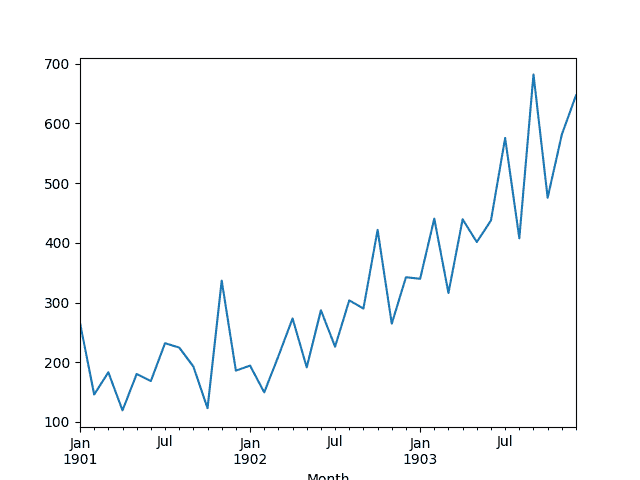
洗發水銷售數據集的線圖
接下來,我們將看一下實驗中使用的模型配置和測試工具。
## 實驗測試線束
本節介紹本教程中使用的測試工具。
### 數據拆分
我們將 Shampoo Sales 數據集分為兩部分:訓練和測試集。
前兩年的數據將用于訓練數據集,剩余的一年數據將用于測試集。
將使用訓練數據集開發模型,并對測試數據集進行預測。
測試數據集的持久性預測(樸素預測)實現了每月洗發水銷售 136.761 的錯誤。這在測試集上提供了較低的可接受表現限制。
### 模型評估
將使用滾動預測場景,也稱為前進模型驗證。
測試數據集的每個時間步驟將一次一個地走。將使用模型對時間步長進行預測,然后將獲取測試集的實際預期值,并使其可用于下一時間步的預測模型。
這模仿了一個真實世界的場景,每個月都會有新的洗發水銷售觀察結果,并用于下個月的預測。
這將通過訓練和測試數據集的結構進行模擬。
將收集關于測試數據集的所有預測,并計算錯誤分數以總結模型的技能。將使用均方根誤差(RMSE),因為它會對大錯誤進行處罰,并產生與預測數據相同的分數,即每月洗發水銷售額。
### 數據準備
在我們將模型擬合到數據集之前,我們必須轉換數據。
在擬合模型和進行預測之前,對數據集執行以下三個數據變換。
1. 轉換時間序列數據,使其靜止不動。具體而言,滯后= 1 差分以消除數據中的增加趨勢。
2. 將時間序列轉換為監督學習問題。具體而言,將數據組織成輸入和輸出模式,其中前一時間步的觀察被用作預測當前時間步的觀察的輸入
3. 將觀察結果轉換為具有特定比例。具體而言,將數據重新調整為-1 到 1 之間的值。
這些變換在預測時反轉,在計算和誤差分數之前將它們恢復到原始比例。
### LSTM 模型
我們將使用基礎狀態 LSTM 模型,其中 1 個神經元適合 1000 個時期。
理想情況下,批量大小為 1 將用于步行前導驗證。我們將假設前進驗證并預測全年的速度。因此,我們可以使用任何可以按樣本數量分割的批量大小,在這種情況下,我們將使用值 4。
理想情況下,將使用更多的訓練時期(例如 1500),但這被截斷為 1000 以保持運行時間合理。
使用有效的 ADAM 優化算法和均方誤差損失函數來擬合模型。
### 實驗運行
每個實驗場景將運行 30 次,并且測試集上的 RMSE 得分將從每次運行結束時記錄。
讓我們深入研究實驗。
## 基線 LSTM 模型
讓我們從基線 LSTM 模型開始。
此問題的基線 LSTM 模型具有以下配置:
* 滯后輸入:1
* 時代:1000
* LSTM 隱藏層中的單位:3
* 批量大小:4
* 重復:3
完整的代碼清單如下。
此代碼清單將用作所有后續實驗的基礎,后續部分中僅提供對此代碼的更改。
```py
from pandas import DataFrame
from pandas import Series
from pandas import concat
from pandas import read_csv
from pandas import datetime
from sklearn.metrics import mean_squared_error
from sklearn.preprocessing import MinMaxScaler
from keras.models import Sequential
from keras.layers import Dense
from keras.layers import LSTM
from keras.regularizers import L1L2
from math import sqrt
import matplotlib
# be able to save images on server
matplotlib.use('Agg')
from matplotlib import pyplot
import numpy
# date-time parsing function for loading the dataset
def parser(x):
return datetime.strptime('190'+x, '%Y-%m')
# frame a sequence as a supervised learning problem
def timeseries_to_supervised(data, lag=1):
df = DataFrame(data)
columns = [df.shift(i) for i in range(1, lag+1)]
columns.append(df)
df = concat(columns, axis=1)
return df
# create a differenced series
def difference(dataset, interval=1):
diff = list()
for i in range(interval, len(dataset)):
value = dataset[i] - dataset[i - interval]
diff.append(value)
return Series(diff)
# invert differenced value
def inverse_difference(history, yhat, interval=1):
return yhat + history[-interval]
# scale train and test data to [-1, 1]
def scale(train, test):
# fit scaler
scaler = MinMaxScaler(feature_range=(-1, 1))
scaler = scaler.fit(train)
# transform train
train = train.reshape(train.shape[0], train.shape[1])
train_scaled = scaler.transform(train)
# transform test
test = test.reshape(test.shape[0], test.shape[1])
test_scaled = scaler.transform(test)
return scaler, train_scaled, test_scaled
# inverse scaling for a forecasted value
def invert_scale(scaler, X, yhat):
new_row = [x for x in X] + [yhat]
array = numpy.array(new_row)
array = array.reshape(1, len(array))
inverted = scaler.inverse_transform(array)
return inverted[0, -1]
# fit an LSTM network to training data
def fit_lstm(train, n_batch, nb_epoch, n_neurons):
X, y = train[:, 0:-1], train[:, -1]
X = X.reshape(X.shape[0], 1, X.shape[1])
model = Sequential()
model.add(LSTM(n_neurons, batch_input_shape=(n_batch, X.shape[1], X.shape[2]), stateful=True))
model.add(Dense(1))
model.compile(loss='mean_squared_error', optimizer='adam')
for i in range(nb_epoch):
model.fit(X, y, epochs=1, batch_size=n_batch, verbose=0, shuffle=False)
model.reset_states()
return model
# run a repeated experiment
def experiment(series, n_lag, n_repeats, n_epochs, n_batch, n_neurons):
# transform data to be stationary
raw_values = series.values
diff_values = difference(raw_values, 1)
# transform data to be supervised learning
supervised = timeseries_to_supervised(diff_values, n_lag)
supervised_values = supervised.values[n_lag:,:]
# split data into train and test-sets
train, test = supervised_values[0:-12], supervised_values[-12:]
# transform the scale of the data
scaler, train_scaled, test_scaled = scale(train, test)
# run experiment
error_scores = list()
for r in range(n_repeats):
# fit the model
train_trimmed = train_scaled[2:, :]
lstm_model = fit_lstm(train_trimmed, n_batch, n_epochs, n_neurons)
# forecast test dataset
test_reshaped = test_scaled[:,0:-1]
test_reshaped = test_reshaped.reshape(len(test_reshaped), 1, 1)
output = lstm_model.predict(test_reshaped, batch_size=n_batch)
predictions = list()
for i in range(len(output)):
yhat = output[i,0]
X = test_scaled[i, 0:-1]
# invert scaling
yhat = invert_scale(scaler, X, yhat)
# invert differencing
yhat = inverse_difference(raw_values, yhat, len(test_scaled)+1-i)
# store forecast
predictions.append(yhat)
# report performance
rmse = sqrt(mean_squared_error(raw_values[-12:], predictions))
print('%d) Test RMSE: %.3f' % (r+1, rmse))
error_scores.append(rmse)
return error_scores
# configure the experiment
def run():
# load dataset
series = read_csv('shampoo-sales.csv', header=0, parse_dates=[0], index_col=0, squeeze=True, date_parser=parser)
# configure the experiment
n_lag = 1
n_repeats = 30
n_epochs = 1000
n_batch = 4
n_neurons = 3
# run the experiment
results = DataFrame()
results['results'] = experiment(series, n_lag, n_repeats, n_epochs, n_batch, n_neurons)
# summarize results
print(results.describe())
# save boxplot
results.boxplot()
pyplot.savefig('experiment_baseline.png')
# entry point
run()
```
運行實驗將打印所有重復測試 RMSE 的摘要統計信息。
我們可以看到,平均而言,這種模型配置實現了約 92 個月洗發水銷售的測試 RMSE,標準偏差為 5。
```py
results
count 30.000000
mean 92.842537
std 5.748456
min 81.205979
25% 89.514367
50% 92.030003
75% 96.926145
max 105.247117
```
還會根據測試 RMSE 結果的分布創建一個盒子和胡須圖并保存到文件中。
該圖清楚地描述了結果的傳播,突出了中間 50%的值(框)和中位數(綠線)。
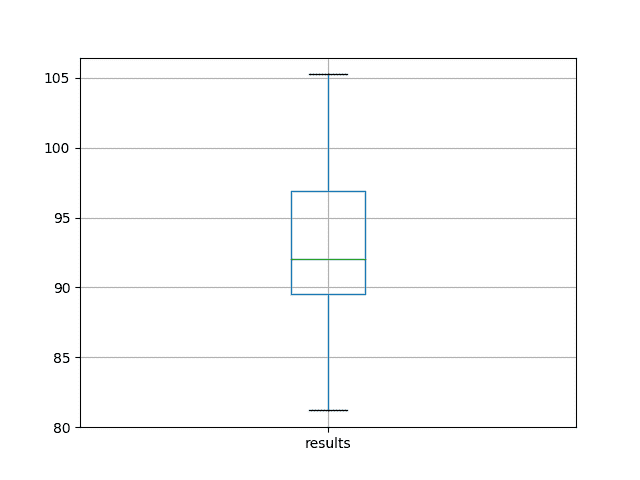
洗發水銷售數據集中基線表現的盒子和晶須圖
## 偏差權重正則化
權重正則化可以應用于 LSTM 節點內的偏置連接。
在 Keras 中,在創建 LSTM 層時使用 _bias_regularizer_ 參數指定。正則化器被定義為 L1,L2 或 L1L2 類之一的實例。
更多細節在這里:
* [Keras 用于規范制定者](https://keras.io/regularizers/)
在本實驗中,我們將 L1,L2 和 L1L2 與基線模型的默認值 0.01 進行比較。我們可以使用 L1L2 類指定所有配置,如下所示:
* L1L2(0.0,0.0)[例如基線]
* L1L2(0.01,0.0)[例如 L1]
* L1L2(0.0,0.01)[例如 L2]
* L1L2(0.01,0.01)[例如 L1L2 或彈性網]
下面列出了更新的 _fit_lstm()_,_ 實驗()_ 和 _run()_ 函數,用于使用 LSTM 的偏置權重正則化。
```py
# fit an LSTM network to training data
def fit_lstm(train, n_batch, nb_epoch, n_neurons, reg):
X, y = train[:, 0:-1], train[:, -1]
X = X.reshape(X.shape[0], 1, X.shape[1])
model = Sequential()
model.add(LSTM(n_neurons, batch_input_shape=(n_batch, X.shape[1], X.shape[2]), stateful=True, bias_regularizer=reg))
model.add(Dense(1))
model.compile(loss='mean_squared_error', optimizer='adam')
for i in range(nb_epoch):
model.fit(X, y, epochs=1, batch_size=n_batch, verbose=0, shuffle=False)
model.reset_states()
return model
# run a repeated experiment
def experiment(series, n_lag, n_repeats, n_epochs, n_batch, n_neurons, reg):
# transform data to be stationary
raw_values = series.values
diff_values = difference(raw_values, 1)
# transform data to be supervised learning
supervised = timeseries_to_supervised(diff_values, n_lag)
supervised_values = supervised.values[n_lag:,:]
# split data into train and test-sets
train, test = supervised_values[0:-12], supervised_values[-12:]
# transform the scale of the data
scaler, train_scaled, test_scaled = scale(train, test)
# run experiment
error_scores = list()
for r in range(n_repeats):
# fit the model
train_trimmed = train_scaled[2:, :]
lstm_model = fit_lstm(train_trimmed, n_batch, n_epochs, n_neurons, reg)
# forecast test dataset
test_reshaped = test_scaled[:,0:-1]
test_reshaped = test_reshaped.reshape(len(test_reshaped), 1, 1)
output = lstm_model.predict(test_reshaped, batch_size=n_batch)
predictions = list()
for i in range(len(output)):
yhat = output[i,0]
X = test_scaled[i, 0:-1]
# invert scaling
yhat = invert_scale(scaler, X, yhat)
# invert differencing
yhat = inverse_difference(raw_values, yhat, len(test_scaled)+1-i)
# store forecast
predictions.append(yhat)
# report performance
rmse = sqrt(mean_squared_error(raw_values[-12:], predictions))
print('%d) Test RMSE: %.3f' % (r+1, rmse))
error_scores.append(rmse)
return error_scores
# configure the experiment
def run():
# load dataset
series = read_csv('shampoo-sales.csv', header=0, parse_dates=[0], index_col=0, squeeze=True, date_parser=parser)
# configure the experiment
n_lag = 1
n_repeats = 30
n_epochs = 1000
n_batch = 4
n_neurons = 3
regularizers = [L1L2(l1=0.0, l2=0.0), L1L2(l1=0.01, l2=0.0), L1L2(l1=0.0, l2=0.01), L1L2(l1=0.01, l2=0.01)]
# run the experiment
results = DataFrame()
for reg in regularizers:
name = ('l1 %.2f,l2 %.2f' % (reg.l1, reg.l2))
results[name] = experiment(series, n_lag, n_repeats, n_epochs, n_batch, n_neurons, reg)
# summarize results
print(results.describe())
# save boxplot
results.boxplot()
pyplot.savefig('experiment_reg_bias.png')
```
運行此實驗會打印每個已評估配置的描述性統計信息。
結果表明,與所考慮的所有其他配置相比,平均而言,無偏差正則化的默認值導致更好的表現。
```py
l1 0.00,l2 0.00 l1 0.01,l2 0.00 l1 0.00,l2 0.01 l1 0.01,l2 0.01
count 30.000000 30.000000 30.000000 30.000000
mean 92.821489 95.520003 93.285389 92.901021
std 4.894166 3.637022 3.906112 5.082358
min 81.394504 89.477398 82.994480 78.729224
25% 89.356330 93.017723 90.907343 91.210105
50% 92.822871 95.502700 93.837562 94.525965
75% 95.899939 98.195980 95.426270 96.882378
max 101.194678 101.750900 100.650130 97.766301
```
還會創建一個框和胡須圖來比較每個配置的結果分布。
該圖顯示所有配置具有大約相同的擴展,并且均勻地添加偏置正則化對該問題沒有幫助。
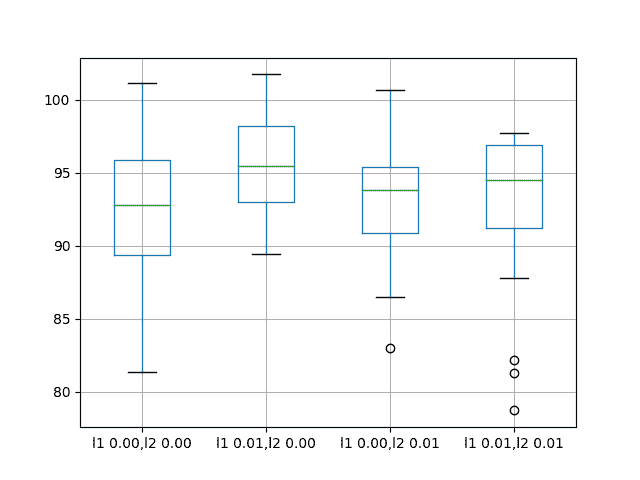
在洗發水銷售數據集中偏差重量正規化的盒子和晶須圖
## 輸入權重正則化
我們還可以將正則化應用于每個 LSTM 單元上的輸入連接。
在 Keras 中,這是通過將 _kernel_regularizer_ 參數設置為正則化類來實現的。
我們將測試與前一節中使用的相同的正則化器配置,具體為:
* L1L2(0.0,0.0)[例如基線]
* L1L2(0.01,0.0)[例如 L1]
* L1L2(0.0,0.01)[例如 L2]
* L1L2(0.01,0.01)[例如 L1L2 或彈性網]
下面列出了更新的 _fit_lstm()_,_ 實驗()_ 和 _run()_ 函數,用于使用 LSTM 的偏置權重正則化。
```py
# fit an LSTM network to training data
def fit_lstm(train, n_batch, nb_epoch, n_neurons, reg):
X, y = train[:, 0:-1], train[:, -1]
X = X.reshape(X.shape[0], 1, X.shape[1])
model = Sequential()
model.add(LSTM(n_neurons, batch_input_shape=(n_batch, X.shape[1], X.shape[2]), stateful=True, kernel_regularizer=reg))
model.add(Dense(1))
model.compile(loss='mean_squared_error', optimizer='adam')
for i in range(nb_epoch):
model.fit(X, y, epochs=1, batch_size=n_batch, verbose=0, shuffle=False)
model.reset_states()
return model
# run a repeated experiment
def experiment(series, n_lag, n_repeats, n_epochs, n_batch, n_neurons, reg):
# transform data to be stationary
raw_values = series.values
diff_values = difference(raw_values, 1)
# transform data to be supervised learning
supervised = timeseries_to_supervised(diff_values, n_lag)
supervised_values = supervised.values[n_lag:,:]
# split data into train and test-sets
train, test = supervised_values[0:-12], supervised_values[-12:]
# transform the scale of the data
scaler, train_scaled, test_scaled = scale(train, test)
# run experiment
error_scores = list()
for r in range(n_repeats):
# fit the model
train_trimmed = train_scaled[2:, :]
lstm_model = fit_lstm(train_trimmed, n_batch, n_epochs, n_neurons, reg)
# forecast test dataset
test_reshaped = test_scaled[:,0:-1]
test_reshaped = test_reshaped.reshape(len(test_reshaped), 1, 1)
output = lstm_model.predict(test_reshaped, batch_size=n_batch)
predictions = list()
for i in range(len(output)):
yhat = output[i,0]
X = test_scaled[i, 0:-1]
# invert scaling
yhat = invert_scale(scaler, X, yhat)
# invert differencing
yhat = inverse_difference(raw_values, yhat, len(test_scaled)+1-i)
# store forecast
predictions.append(yhat)
# report performance
rmse = sqrt(mean_squared_error(raw_values[-12:], predictions))
print('%d) Test RMSE: %.3f' % (r+1, rmse))
error_scores.append(rmse)
return error_scores
# configure the experiment
def run():
# load dataset
series = read_csv('shampoo-sales.csv', header=0, parse_dates=[0], index_col=0, squeeze=True, date_parser=parser)
# configure the experiment
n_lag = 1
n_repeats = 30
n_epochs = 1000
n_batch = 4
n_neurons = 3
regularizers = [L1L2(l1=0.0, l2=0.0), L1L2(l1=0.01, l2=0.0), L1L2(l1=0.0, l2=0.01), L1L2(l1=0.01, l2=0.01)]
# run the experiment
results = DataFrame()
for reg in regularizers:
name = ('l1 %.2f,l2 %.2f' % (reg.l1, reg.l2))
results[name] = experiment(series, n_lag, n_repeats, n_epochs, n_batch, n_neurons, reg)
# summarize results
print(results.describe())
# save boxplot
results.boxplot()
pyplot.savefig('experiment_reg_input.png')
```
運行此實驗會打印每個已評估配置的描述性統計信息。
結果表明,在輸入連接中增加重量正則化確實在這種設置上提供了全面的好處。
我們可以看到,對于所有配置,測試 RMSE 大約低 10 個單位,當 L1 和 L2 都組合成彈性網類型約束時,可能會帶來更多好處。
```py
l1 0.00,l2 0.00 l1 0.01,l2 0.00 l1 0.00,l2 0.01 l1 0.01,l2 0.01
count 30.000000 30.000000 30.000000 30.000000
mean 91.640028 82.118980 82.137198 80.471685
std 6.086401 4.116072 3.378984 2.212213
min 80.392310 75.705210 76.005173 76.550909
25% 88.025135 79.237822 79.698162 78.780802
50% 91.843761 81.235433 81.463882 80.283913
75% 94.860117 85.510177 84.563980 82.443390
max 105.820586 94.210503 90.823454 85.243135
```
還會創建一個框和胡須圖來比較每個配置的結果分布。
該圖顯示了輸入正則化的一般較低的誤差分布。結果還表明,隨著 L1L2 配置獲得更好的結果,正則化結果可能更加明顯。
這是一個令人鼓舞的發現,表明用于輸入正則化的具有不同 L1L2 值的額外實驗將是值得研究的。
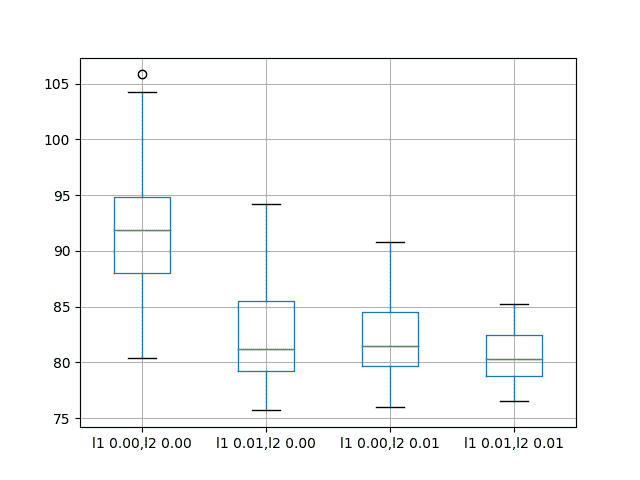
洗發水銷售數據集中輸入重量正規化表現的盒子和晶須圖
## 復發性體重正則化
最后,我們還可以將正則化應用于每個 LSTM 單元上的循環連接。
在 Keras 中,這是通過將 _recurrent_regularizer_ 參數設置為正則化類來實現的。
我們將測試與前一節中使用的相同的正則化器配置,具體為:
* L1L2(0.0,0.0)[例如基線]
* L1L2(0.01,0.0)[例如 L1]
* L1L2(0.0,0.01)[例如 L2]
* L1L2(0.01,0.01)[例如 L1L2 或彈性網]
下面列出了更新的 _fit_lstm()_,_ 實驗()_ 和 _run()_ 函數,用于使用 LSTM 的偏置權重正則化。
```py
# fit an LSTM network to training data
def fit_lstm(train, n_batch, nb_epoch, n_neurons, reg):
X, y = train[:, 0:-1], train[:, -1]
X = X.reshape(X.shape[0], 1, X.shape[1])
model = Sequential()
model.add(LSTM(n_neurons, batch_input_shape=(n_batch, X.shape[1], X.shape[2]), stateful=True, recurrent_regularizer=reg))
model.add(Dense(1))
model.compile(loss='mean_squared_error', optimizer='adam')
for i in range(nb_epoch):
model.fit(X, y, epochs=1, batch_size=n_batch, verbose=0, shuffle=False)
model.reset_states()
return model
# run a repeated experiment
def experiment(series, n_lag, n_repeats, n_epochs, n_batch, n_neurons, reg):
# transform data to be stationary
raw_values = series.values
diff_values = difference(raw_values, 1)
# transform data to be supervised learning
supervised = timeseries_to_supervised(diff_values, n_lag)
supervised_values = supervised.values[n_lag:,:]
# split data into train and test-sets
train, test = supervised_values[0:-12], supervised_values[-12:]
# transform the scale of the data
scaler, train_scaled, test_scaled = scale(train, test)
# run experiment
error_scores = list()
for r in range(n_repeats):
# fit the model
train_trimmed = train_scaled[2:, :]
lstm_model = fit_lstm(train_trimmed, n_batch, n_epochs, n_neurons, reg)
# forecast test dataset
test_reshaped = test_scaled[:,0:-1]
test_reshaped = test_reshaped.reshape(len(test_reshaped), 1, 1)
output = lstm_model.predict(test_reshaped, batch_size=n_batch)
predictions = list()
for i in range(len(output)):
yhat = output[i,0]
X = test_scaled[i, 0:-1]
# invert scaling
yhat = invert_scale(scaler, X, yhat)
# invert differencing
yhat = inverse_difference(raw_values, yhat, len(test_scaled)+1-i)
# store forecast
predictions.append(yhat)
# report performance
rmse = sqrt(mean_squared_error(raw_values[-12:], predictions))
print('%d) Test RMSE: %.3f' % (r+1, rmse))
error_scores.append(rmse)
return error_scores
# configure the experiment
def run():
# load dataset
series = read_csv('shampoo-sales.csv', header=0, parse_dates=[0], index_col=0, squeeze=True, date_parser=parser)
# configure the experiment
n_lag = 1
n_repeats = 30
n_epochs = 1000
n_batch = 4
n_neurons = 3
regularizers = [L1L2(l1=0.0, l2=0.0), L1L2(l1=0.01, l2=0.0), L1L2(l1=0.0, l2=0.01), L1L2(l1=0.01, l2=0.01)]
# run the experiment
results = DataFrame()
for reg in regularizers:
name = ('l1 %.2f,l2 %.2f' % (reg.l1, reg.l2))
results[name] = experiment(series, n_lag, n_repeats, n_epochs, n_batch, n_neurons, reg)
# summarize results
print(results.describe())
# save boxplot
results.boxplot()
pyplot.savefig('experiment_reg_recurrent.png')
```
運行此實驗會打印每個已評估配置的描述性統計信息。
結果表明,對 LSTM 的復發連接使用正則化對此問題沒有明顯的好處。
嘗試的所有變化的平均表現導致比基線模型更差的表現。
```py
l1 0.00,l2 0.00 l1 0.01,l2 0.00 l1 0.00,l2 0.01 l1 0.01,l2 0.01
count 30.000000 30.000000 30.000000 30.000000
mean 92.918797 100.675386 101.302169 96.820026
std 7.172764 3.866547 5.228815 3.966710
min 72.967841 93.789854 91.063592 89.367600
25% 90.311185 98.014045 98.222732 94.787647
50% 92.327824 100.546756 101.903350 95.727549
75% 95.989761 103.491192 104.918266 98.240613
max 110.529422 108.788604 110.712064 111.185747
```
還會創建一個框和胡須圖來比較每個配置的結果分布。
該圖顯示了與摘要統計相同的故事,表明使用復發體重正則化幾乎沒有益處。
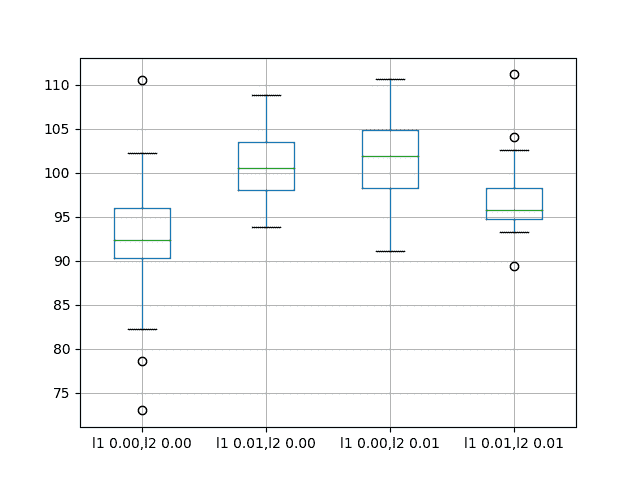
洗發水銷售數據集中復發重量正常化的盒子和晶須圖
## 擴展
本節列出了后續實驗的想法,以擴展本教程中的工作。
* **輸入權重正則化**。輸入權重正則化對該問題的實驗結果表明了上市績效的巨大希望。這可以通過網格搜索不同的 L1 和 L2 值來進一步研究,以找到最佳配置。
* **行為動態**。可以通過在訓練時期上繪制訓練和測試 RMSE 來研究每個權重正則化方案的動態行為,以獲得對過度擬合或欠擬合行為模式的權重正則化的想法。
* **結合正則化**。可以設計實驗來探索組合不同重量正則化方案的效果。
* **激活正則化**。 Keras 還支持激活正則化,這可能是探索對 LSTM 施加約束并減少過度擬合的另一種途徑。
## 摘要
在本教程中,您了解了如何將權重正則化與 LSTM 一起用于時間序列預測。
具體來說,你學到了:
* 如何設計一個強大的測試工具來評估 LSTM 網絡的時間序列預測。
* 如何在 LSTM 上配置偏差權重正則化用于時間序列預測。
* 如何在 LSTM 上配置輸入和循環權重正則化以進行時間序列預測。
您對使用 LSTM 網絡的權重正則化有任何疑問嗎?
在下面的評論中提出您的問題,我會盡力回答。
- Machine Learning Mastery 應用機器學習教程
- 5競爭機器學習的好處
- 過度擬合的簡單直覺,或者為什么測試訓練數據是一個壞主意
- 特征選擇簡介
- 應用機器學習作為一個搜索問題的溫和介紹
- 為什么應用機器學習很難
- 為什么我的結果不如我想的那么好?你可能過度擬合了
- 用ROC曲線評估和比較分類器表現
- BigML評論:發現本機學習即服務平臺的聰明功能
- BigML教程:開發您的第一個決策樹并進行預測
- 構建生產機器學習基礎設施
- 分類準確性不夠:可以使用更多表現測量
- 一種預測模型的巧妙應用
- 機器學習項目中常見的陷阱
- 數據清理:將凌亂的數據轉換為整潔的數據
- 機器學習中的數據泄漏
- 數據,學習和建模
- 數據管理至關重要以及為什么需要認真對待它
- 將預測模型部署到生產中
- 參數和超參數之間有什么區別?
- 測試和驗證數據集之間有什么區別?
- 發現特征工程,如何設計特征以及如何獲得它
- 如何開始使用Kaggle
- 超越預測
- 如何在評估機器學習算法時選擇正確的測試選項
- 如何定義機器學習問題
- 如何評估機器學習算法
- 如何獲得基線結果及其重要性
- 如何充分利用機器學習數據
- 如何識別數據中的異常值
- 如何提高機器學習效果
- 如何在競爭機器學習中踢屁股
- 如何知道您的機器學習模型是否具有良好的表現
- 如何布局和管理您的機器學習項目
- 如何為機器學習準備數據
- 如何減少最終機器學習模型中的方差
- 如何使用機器學習結果
- 如何解決像數據科學家這樣的問題
- 通過數據預處理提高模型精度
- 處理機器學習的大數據文件的7種方法
- 建立機器學習系統的經驗教訓
- 如何使用機器學習清單可靠地獲得準確的預測(即使您是初學者)
- 機器學習模型運行期間要做什么
- 機器學習表現改進備忘單
- 來自世界級從業者的機器學習技巧:Phil Brierley
- 模型預測精度與機器學習中的解釋
- 競爭機器學習的模型選擇技巧
- 機器學習需要多少訓練數據?
- 如何系統地規劃和運行機器學習實驗
- 應用機器學習過程
- 默認情況下可重現的機器學習結果
- 10個實踐應用機器學習的標準數據集
- 簡單的三步法到最佳機器學習算法
- 打擊機器學習數據集中不平衡類的8種策略
- 模型表現不匹配問題(以及如何處理)
- 黑箱機器學習的誘惑陷阱
- 如何培養最終的機器學習模型
- 使用探索性數據分析了解您的問題并獲得更好的結果
- 什么是數據挖掘和KDD
- 為什么One-Hot在機器學習中編碼數據?
- 為什么你應該在你的機器學習問題上進行抽樣檢查算法
- 所以,你正在研究機器學習問題......
- Machine Learning Mastery Keras 深度學習教程
- Keras 中神經網絡模型的 5 步生命周期
- 在 Python 迷你課程中應用深度學習
- Keras 深度學習庫的二元分類教程
- 如何用 Keras 構建多層感知器神經網絡模型
- 如何在 Keras 中檢查深度學習模型
- 10 個用于 Amazon Web Services 深度學習的命令行秘籍
- 機器學習卷積神經網絡的速成課程
- 如何在 Python 中使用 Keras 進行深度學習的度量
- 深度學習書籍
- 深度學習課程
- 你所知道的深度學習是一種謊言
- 如何設置 Amazon AWS EC2 GPU 以訓練 Keras 深度學習模型(分步)
- 神經網絡中批量和迭代之間的區別是什么?
- 在 Keras 展示深度學習模型訓練歷史
- 基于 Keras 的深度學習模型中的dropout正則化
- 評估 Keras 中深度學習模型的表現
- 如何評價深度學習模型的技巧
- 小批量梯度下降的簡要介紹以及如何配置批量大小
- 在 Keras 中獲得深度學習幫助的 9 種方法
- 如何使用 Keras 在 Python 中網格搜索深度學習模型的超參數
- 用 Keras 在 Python 中使用卷積神經網絡進行手寫數字識別
- 如何用 Keras 進行預測
- 用 Keras 進行深度學習的圖像增強
- 8 個深度學習的鼓舞人心的應用
- Python 深度學習庫 Keras 簡介
- Python 深度學習庫 TensorFlow 簡介
- Python 深度學習庫 Theano 簡介
- 如何使用 Keras 函數式 API 進行深度學習
- Keras 深度學習庫的多類分類教程
- 多層感知器神經網絡速成課程
- 基于卷積神經網絡的 Keras 深度學習庫中的目標識別
- 流行的深度學習庫
- 用深度學習預測電影評論的情感
- Python 中的 Keras 深度學習庫的回歸教程
- 如何使用 Keras 獲得可重現的結果
- 如何在 Linux 服務器上運行深度學習實驗
- 保存并加載您的 Keras 深度學習模型
- 用 Keras 逐步開發 Python 中的第一個神經網絡
- 用 Keras 理解 Python 中的有狀態 LSTM 循環神經網絡
- 在 Python 中使用 Keras 深度學習模型和 Scikit-Learn
- 如何使用預訓練的 VGG 模型對照片中的物體進行分類
- 在 Python 和 Keras 中對深度學習模型使用學習率調度
- 如何在 Keras 中可視化深度學習神經網絡模型
- 什么是深度學習?
- 何時使用 MLP,CNN 和 RNN 神經網絡
- 為什么用隨機權重初始化神經網絡?
- Machine Learning Mastery 深度學習 NLP 教程
- 深度學習在自然語言處理中的 7 個應用
- 如何實現自然語言處理的波束搜索解碼器
- 深度學習文檔分類的最佳實踐
- 關于自然語言處理的熱門書籍
- 在 Python 中計算文本 BLEU 分數的溫和介紹
- 使用編碼器 - 解碼器模型的用于字幕生成的注入和合并架構
- 如何用 Python 清理機器學習的文本
- 如何配置神經機器翻譯的編碼器 - 解碼器模型
- 如何開始深度學習自然語言處理(7 天迷你課程)
- 自然語言處理的數據集
- 如何開發一種深度學習的詞袋模型來預測電影評論情感
- 深度學習字幕生成模型的溫和介紹
- 如何在 Keras 中定義神經機器翻譯的編碼器 - 解碼器序列 - 序列模型
- 如何利用小實驗在 Keras 中開發字幕生成模型
- 如何從頭開發深度學習圖片標題生成器
- 如何在 Keras 中開發基于字符的神經語言模型
- 如何開發用于情感分析的 N-gram 多通道卷積神經網絡
- 如何從零開始開發神經機器翻譯系統
- 如何在 Python 中用 Keras 開發基于單詞的神經語言模型
- 如何開發一種預測電影評論情感的詞嵌入模型
- 如何使用 Gensim 在 Python 中開發詞嵌入
- 用于文本摘要的編碼器 - 解碼器深度學習模型
- Keras 中文本摘要的編碼器 - 解碼器模型
- 用于神經機器翻譯的編碼器 - 解碼器循環神經網絡模型
- 淺談詞袋模型
- 文本摘要的溫和介紹
- 編碼器 - 解碼器循環神經網絡中的注意力如何工作
- 如何利用深度學習自動生成照片的文本描述
- 如何開發一個單詞級神經語言模型并用它來生成文本
- 淺談神經機器翻譯
- 什么是自然語言處理?
- 牛津自然語言處理深度學習課程
- 如何為機器翻譯準備法語到英語的數據集
- 如何為情感分析準備電影評論數據
- 如何為文本摘要準備新聞文章
- 如何準備照片標題數據集以訓練深度學習模型
- 如何使用 Keras 為深度學習準備文本數據
- 如何使用 scikit-learn 為機器學習準備文本數據
- 自然語言處理神經網絡模型入門
- 對自然語言處理的深度學習的承諾
- 在 Python 中用 Keras 進行 LSTM 循環神經網絡的序列分類
- 斯坦福自然語言處理深度學習課程評價
- 統計語言建模和神經語言模型的簡要介紹
- 使用 Keras 在 Python 中進行 LSTM 循環神經網絡的文本生成
- 淺談機器學習中的轉換
- 如何使用 Keras 將詞嵌入層用于深度學習
- 什么是用于文本的詞嵌入
- Machine Learning Mastery 深度學習時間序列教程
- 如何開發人類活動識別的一維卷積神經網絡模型
- 人類活動識別的深度學習模型
- 如何評估人類活動識別的機器學習算法
- 時間序列預測的多層感知器網絡探索性配置
- 比較經典和機器學習方法進行時間序列預測的結果
- 如何通過深度學習快速獲得時間序列預測的結果
- 如何利用 Python 處理序列預測問題中的缺失時間步長
- 如何建立預測大氣污染日的概率預測模型
- 如何開發一種熟練的機器學習時間序列預測模型
- 如何構建家庭用電自回歸預測模型
- 如何開發多步空氣污染時間序列預測的自回歸預測模型
- 如何制定多站點多元空氣污染時間序列預測的基線預測
- 如何開發時間序列預測的卷積神經網絡模型
- 如何開發卷積神經網絡用于多步時間序列預測
- 如何開發單變量時間序列預測的深度學習模型
- 如何開發 LSTM 模型用于家庭用電的多步時間序列預測
- 如何開發 LSTM 模型進行時間序列預測
- 如何開發多元多步空氣污染時間序列預測的機器學習模型
- 如何開發多層感知器模型進行時間序列預測
- 如何開發人類活動識別時間序列分類的 RNN 模型
- 如何開始深度學習的時間序列預測(7 天迷你課程)
- 如何網格搜索深度學習模型進行時間序列預測
- 如何對單變量時間序列預測的網格搜索樸素方法
- 如何在 Python 中搜索 SARIMA 模型超參數用于時間序列預測
- 如何在 Python 中進行時間序列預測的網格搜索三次指數平滑
- 一個標準的人類活動識別問題的溫和介紹
- 如何加載和探索家庭用電數據
- 如何加載,可視化和探索復雜的多變量多步時間序列預測數據集
- 如何從智能手機數據模擬人類活動
- 如何根據環境因素預測房間占用率
- 如何使用腦波預測人眼是開放還是閉合
- 如何在 Python 中擴展長短期內存網絡的數據
- 如何使用 TimeseriesGenerator 進行 Keras 中的時間序列預測
- 基于機器學習算法的室內運動時間序列分類
- 用于時間序列預測的狀態 LSTM 在線學習的不穩定性
- 用于罕見事件時間序列預測的 LSTM 模型體系結構
- 用于時間序列預測的 4 種通用機器學習數據變換
- Python 中長短期記憶網絡的多步時間序列預測
- 家庭用電機器學習的多步時間序列預測
- Keras 中 LSTM 的多變量時間序列預測
- 如何開發和評估樸素的家庭用電量預測方法
- 如何為長短期記憶網絡準備單變量時間序列數據
- 循環神經網絡在時間序列預測中的應用
- 如何在 Python 中使用差異變換刪除趨勢和季節性
- 如何在 LSTM 中種子狀態用于 Python 中的時間序列預測
- 使用 Python 進行時間序列預測的有狀態和無狀態 LSTM
- 長短時記憶網絡在時間序列預測中的適用性
- 時間序列預測問題的分類
- Python 中長短期記憶網絡的時間序列預測
- 基于 Keras 的 Python 中 LSTM 循環神經網絡的時間序列預測
- Keras 中深度學習的時間序列預測
- 如何用 Keras 調整 LSTM 超參數進行時間序列預測
- 如何在時間序列預測訓練期間更新 LSTM 網絡
- 如何使用 LSTM 網絡的 Dropout 進行時間序列預測
- 如何使用 LSTM 網絡中的特征進行時間序列預測
- 如何在 LSTM 網絡中使用時間序列進行時間序列預測
- 如何利用 LSTM 網絡進行權重正則化進行時間序列預測
- Machine Learning Mastery 線性代數教程
- 機器學習數學符號的基礎知識
- 用 NumPy 陣列輕松介紹廣播
- 如何從 Python 中的 Scratch 計算主成分分析(PCA)
- 用于編碼器審查的計算線性代數
- 10 機器學習中的線性代數示例
- 線性代數的溫和介紹
- 用 NumPy 輕松介紹 Python 中的 N 維數組
- 機器學習向量的溫和介紹
- 如何在 Python 中為機器學習索引,切片和重塑 NumPy 數組
- 機器學習的矩陣和矩陣算法簡介
- 溫和地介紹機器學習的特征分解,特征值和特征向量
- NumPy 對預期價值,方差和協方差的簡要介紹
- 機器學習矩陣分解的溫和介紹
- 用 NumPy 輕松介紹機器學習的張量
- 用于機器學習的線性代數中的矩陣類型簡介
- 用于機器學習的線性代數備忘單
- 線性代數的深度學習
- 用于機器學習的線性代數(7 天迷你課程)
- 機器學習的線性代數
- 機器學習矩陣運算的溫和介紹
- 線性代數評論沒有廢話指南
- 學習機器學習線性代數的主要資源
- 淺談機器學習的奇異值分解
- 如何用線性代數求解線性回歸
- 用于機器學習的稀疏矩陣的溫和介紹
- 機器學習中向量規范的溫和介紹
- 學習線性代數用于機器學習的 5 個理由
- Machine Learning Mastery LSTM 教程
- Keras中長短期記憶模型的5步生命周期
- 長短時記憶循環神經網絡的注意事項
- CNN長短期記憶網絡
- 逆向神經網絡中的深度學習速成課程
- 可變長度輸入序列的數據準備
- 如何用Keras開發用于Python序列分類的雙向LSTM
- 如何開發Keras序列到序列預測的編碼器 - 解碼器模型
- 如何診斷LSTM模型的過度擬合和欠擬合
- 如何開發一種編碼器 - 解碼器模型,注重Keras中的序列到序列預測
- 編碼器 - 解碼器長短期存儲器網絡
- 神經網絡中爆炸梯度的溫和介紹
- 對時間反向傳播的溫和介紹
- 生成長短期記憶網絡的溫和介紹
- 專家對長短期記憶網絡的簡要介紹
- 在序列預測問題上充分利用LSTM
- 編輯器 - 解碼器循環神經網絡全局注意的溫和介紹
- 如何利用長短時記憶循環神經網絡處理很長的序列
- 如何在Python中對一個熱編碼序列數據
- 如何使用編碼器 - 解碼器LSTM來回顯隨機整數序列
- 具有注意力的編碼器 - 解碼器RNN體系結構的實現模式
- 學習使用編碼器解碼器LSTM循環神經網絡添加數字
- 如何學習長短時記憶循環神經網絡回聲隨機整數
- 具有Keras的長短期記憶循環神經網絡的迷你課程
- LSTM自動編碼器的溫和介紹
- 如何用Keras中的長短期記憶模型進行預測
- 用Python中的長短期內存網絡演示內存
- 基于循環神經網絡的序列預測模型的簡要介紹
- 深度學習的循環神經網絡算法之旅
- 如何重塑Keras中長短期存儲網絡的輸入數據
- 了解Keras中LSTM的返回序列和返回狀態之間的差異
- RNN展開的溫和介紹
- 5學習LSTM循環神經網絡的簡單序列預測問題的例子
- 使用序列進行預測
- 堆疊長短期內存網絡
- 什么是教師強制循環神經網絡?
- 如何在Python中使用TimeDistributed Layer for Long Short-Term Memory Networks
- 如何準備Keras中截斷反向傳播的序列預測
- 如何在使用LSTM進行訓練和預測時使用不同的批量大小
- Machine Learning Mastery 機器學習算法教程
- 機器學習算法之旅
- 用于機器學習的裝袋和隨機森林集合算法
- 從頭開始實施機器學習算法的好處
- 更好的樸素貝葉斯:從樸素貝葉斯算法中獲取最多的12個技巧
- 機器學習的提升和AdaBoost
- 選擇機器學習算法:Microsoft Azure的經驗教訓
- 機器學習的分類和回歸樹
- 什么是機器學習中的混淆矩陣
- 如何使用Python從頭開始創建算法測試工具
- 通過創建機器學習算法的目標列表來控制
- 從頭開始停止編碼機器學習算法
- 在實現機器學習算法時,不要從開源代碼開始
- 不要使用隨機猜測作為基線分類器
- 淺談機器學習中的概念漂移
- 溫和介紹機器學習中的偏差 - 方差權衡
- 機器學習的梯度下降
- 機器學習算法如何工作(他們學習輸入到輸出的映射)
- 如何建立機器學習算法的直覺
- 如何實現機器學習算法
- 如何研究機器學習算法行為
- 如何學習機器學習算法
- 如何研究機器學習算法
- 如何研究機器學習算法
- 如何在Python中從頭開始實現反向傳播算法
- 如何用Python從頭開始實現Bagging
- 如何用Python從頭開始實現基線機器學習算法
- 如何在Python中從頭開始實現決策樹算法
- 如何用Python從頭開始實現學習向量量化
- 如何利用Python從頭開始隨機梯度下降實現線性回歸
- 如何利用Python從頭開始隨機梯度下降實現Logistic回歸
- 如何用Python從頭開始實現機器學習算法表現指標
- 如何在Python中從頭開始實現感知器算法
- 如何在Python中從零開始實現隨機森林
- 如何在Python中從頭開始實現重采樣方法
- 如何用Python從頭開始實現簡單線性回歸
- 如何用Python從頭開始實現堆棧泛化(Stacking)
- K-Nearest Neighbors for Machine Learning
- 學習機器學習的向量量化
- 機器學習的線性判別分析
- 機器學習的線性回歸
- 使用梯度下降進行機器學習的線性回歸教程
- 如何在Python中從頭開始加載機器學習數據
- 機器學習的Logistic回歸
- 機器學習的Logistic回歸教程
- 機器學習算法迷你課程
- 如何在Python中從頭開始實現樸素貝葉斯
- 樸素貝葉斯機器學習
- 樸素貝葉斯機器學習教程
- 機器學習算法的過擬合和欠擬合
- 參數化和非參數機器學習算法
- 理解任何機器學習算法的6個問題
- 在機器學習中擁抱隨機性
- 如何使用Python從頭開始擴展機器學習數據
- 機器學習的簡單線性回歸教程
- 有監督和無監督的機器學習算法
- 用于機器學習的支持向量機
- 在沒有數學背景的情況下理解機器學習算法的5種技術
- 最好的機器學習算法
- 教程從頭開始在Python中實現k-Nearest Neighbors
- 通過從零開始實現它們來理解機器學習算法(以及繞過壞代碼的策略)
- 使用隨機森林:在121個數據集上測試179個分類器
- 為什么從零開始實現機器學習算法
- Machine Learning Mastery 機器學習入門教程
- 機器學習入門的四個步驟:初學者入門與實踐的自上而下策略
- 你應該培養的 5 個機器學習領域
- 一種選擇機器學習算法的數據驅動方法
- 機器學習中的分析與數值解
- 應用機器學習是一種精英政治
- 機器學習的基本概念
- 如何成為數據科學家
- 初學者如何在機器學習中弄錯
- 機器學習的最佳編程語言
- 構建機器學習組合
- 機器學習中分類與回歸的區別
- 評估自己作為數據科學家并利用結果建立驚人的數據科學團隊
- 探索 Kaggle 大師的方法論和心態:對 Diogo Ferreira 的采訪
- 擴展機器學習工具并展示掌握
- 通過尋找地標開始機器學習
- 溫和地介紹預測建模
- 通過提供結果在機器學習中獲得夢想的工作
- 如何開始機器學習:自學藍圖
- 開始并在機器學習方面取得進展
- 應用機器學習的 Hello World
- 初學者如何使用小型項目開始機器學習并在 Kaggle 上進行競爭
- 我如何開始機器學習? (簡短版)
- 我是如何開始機器學習的
- 如何在機器學習中取得更好的成績
- 如何從在銀行工作到擔任 Target 的高級數據科學家
- 如何學習任何機器學習工具
- 使用小型目標項目深入了解機器學習工具
- 獲得付費申請機器學習
- 映射機器學習工具的景觀
- 機器學習開發環境
- 機器學習金錢
- 程序員的機器學習
- 機器學習很有意思
- 機器學習是 Kaggle 比賽
- 機器學習現在很受歡迎
- 機器學習掌握方法
- 機器學習很重要
- 機器學習 Q& A:概念漂移,更好的結果和學習更快
- 缺乏自學機器學習的路線圖
- 機器學習很重要
- 快速了解任何機器學習工具(即使您是初學者)
- 機器學習工具
- 找到你的機器學習部落
- 機器學習在一年
- 通過競爭一致的大師 Kaggle
- 5 程序員在機器學習中開始犯錯誤
- 哲學畢業生到機器學習從業者(Brian Thomas 采訪)
- 機器學習入門的實用建議
- 實用機器學習問題
- 使用來自 UCI 機器學習庫的數據集練習機器學習
- 使用秘籍的任何機器學習工具快速啟動
- 程序員可以進入機器學習
- 程序員應該進入機器學習
- 項目焦點:Shashank Singh 的人臉識別
- 項目焦點:使用 Mahout 和 Konstantin Slisenko 進行堆棧交換群集
- 機器學習自學指南
- 4 個自學機器學習項目
- álvaroLemos 如何在數據科學團隊中獲得機器學習實習
- 如何思考機器學習
- 現實世界機器學習問題之旅
- 有關機器學習的有用知識
- 如果我沒有學位怎么辦?
- 如果我不是一個優秀的程序員怎么辦?
- 如果我不擅長數學怎么辦?
- 為什么機器學習算法會處理以前從未見過的數據?
- 是什么阻礙了你的機器學習目標?
- 什么是機器學習?
- 機器學習適合哪里?
- 為什么要進入機器學習?
- 研究對您來說很重要的機器學習問題
- 你這樣做是錯的。為什么機器學習不必如此困難
- Machine Learning Mastery Sklearn 教程
- Scikit-Learn 的溫和介紹:Python 機器學習庫
- 使用 Python 管道和 scikit-learn 自動化機器學習工作流程
- 如何以及何時使用帶有 scikit-learn 的校準分類模型
- 如何比較 Python 中的機器學習算法與 scikit-learn
- 用于機器學習開發人員的 Python 崩潰課程
- 用 scikit-learn 在 Python 中集成機器學習算法
- 使用重采樣評估 Python 中機器學習算法的表現
- 使用 Scikit-Learn 在 Python 中進行特征選擇
- Python 中機器學習的特征選擇
- 如何使用 scikit-learn 在 Python 中生成測試數據集
- scikit-learn 中的機器學習算法秘籍
- 如何使用 Python 處理丟失的數據
- 如何開始使用 Python 進行機器學習
- 如何使用 Scikit-Learn 在 Python 中加載數據
- Python 中概率評分方法的簡要介紹
- 如何用 Scikit-Learn 調整算法參數
- 如何在 Mac OS X 上安裝 Python 3 環境以進行機器學習和深度學習
- 使用 scikit-learn 進行機器學習簡介
- 從 shell 到一本帶有 Fernando Perez 單一工具的書的 IPython
- 如何使用 Python 3 為機器學習開發創建 Linux 虛擬機
- 如何在 Python 中加載機器學習數據
- 您在 Python 中的第一個機器學習項目循序漸進
- 如何使用 scikit-learn 進行預測
- 用于評估 Python 中機器學習算法的度量標準
- 使用 Pandas 為 Python 中的機器學習準備數據
- 如何使用 Scikit-Learn 為 Python 機器學習準備數據
- 項目焦點:使用 Artem Yankov 在 Python 中進行事件推薦
- 用于機器學習的 Python 生態系統
- Python 是應用機器學習的成長平臺
- Python 機器學習書籍
- Python 機器學習迷你課程
- 使用 Pandas 快速和骯臟的數據分析
- 使用 Scikit-Learn 重新調整 Python 中的機器學習數據
- 如何以及何時使用 ROC 曲線和精確調用曲線進行 Python 分類
- 使用 scikit-learn 在 Python 中保存和加載機器學習模型
- scikit-learn Cookbook 書評
- 如何使用 Anaconda 為機器學習和深度學習設置 Python 環境
- 使用 scikit-learn 在 Python 中進行 Spot-Check 分類機器學習算法
- 如何在 Python 中開發可重復使用的抽樣檢查算法框架
- 使用 scikit-learn 在 Python 中進行 Spot-Check 回歸機器學習算法
- 使用 Python 中的描述性統計來了解您的機器學習數據
- 使用 OpenCV,Python 和模板匹配來播放“哪里是 Waldo?”
- 使用 Pandas 在 Python 中可視化機器學習數據
- Machine Learning Mastery 統計學教程
- 淺談計算正態匯總統計量
- 非參數統計的溫和介紹
- Python中常態測試的溫和介紹
- 淺談Bootstrap方法
- 淺談機器學習的中心極限定理
- 淺談機器學習中的大數定律
- 機器學習的所有統計數據
- 如何計算Python中機器學習結果的Bootstrap置信區間
- 淺談機器學習的Chi-Squared測試
- 機器學習的置信區間
- 隨機化在機器學習中解決混雜變量的作用
- 機器學習中的受控實驗
- 機器學習統計學速成班
- 統計假設檢驗的關鍵值以及如何在Python中計算它們
- 如何在機器學習中談論數據(統計學和計算機科學術語)
- Python中數據可視化方法的簡要介紹
- Python中效果大小度量的溫和介紹
- 估計隨機機器學習算法的實驗重復次數
- 機器學習評估統計的溫和介紹
- 如何計算Python中的非參數秩相關性
- 如何在Python中計算數據的5位數摘要
- 如何在Python中從頭開始編寫學生t檢驗
- 如何在Python中生成隨機數
- 如何轉換數據以更好地擬合正態分布
- 如何使用相關來理解變量之間的關系
- 如何使用統計信息識別數據中的異常值
- 用于Python機器學習的隨機數生成器簡介
- k-fold交叉驗證的溫和介紹
- 如何計算McNemar的比較兩種機器學習量詞的測試
- Python中非參數統計顯著性測試簡介
- 如何在Python中使用參數統計顯著性測試
- 機器學習的預測間隔
- 應用統計學與機器學習的密切關系
- 如何使用置信區間報告分類器表現
- 統計數據分布的簡要介紹
- 15 Python中的統計假設檢驗(備忘單)
- 統計假設檢驗的溫和介紹
- 10如何在機器學習項目中使用統計方法的示例
- Python中統計功效和功耗分析的簡要介紹
- 統計抽樣和重新抽樣的簡要介紹
- 比較機器學習算法的統計顯著性檢驗
- 機器學習中統計容差區間的溫和介紹
- 機器學習統計書籍
- 評估機器學習模型的統計數據
- 機器學習統計(7天迷你課程)
- 用于機器學習的簡明英語統計
- 如何使用統計顯著性檢驗來解釋機器學習結果
- 什么是統計(為什么它在機器學習中很重要)?
- Machine Learning Mastery 時間序列入門教程
- 如何在 Python 中為時間序列預測創建 ARIMA 模型
- 用 Python 進行時間序列預測的自回歸模型
- 如何回溯機器學習模型的時間序列預測
- Python 中基于時間序列數據的基本特征工程
- R 的時間序列預測熱門書籍
- 10 挑戰機器學習時間序列預測問題
- 如何將時間序列轉換為 Python 中的監督學習問題
- 如何將時間序列數據分解為趨勢和季節性
- 如何用 ARCH 和 GARCH 模擬波動率進行時間序列預測
- 如何將時間序列數據集與 Python 區分開來
- Python 中時間序列預測的指數平滑的溫和介紹
- 用 Python 進行時間序列預測的特征選擇
- 淺談自相關和部分自相關
- 時間序列預測的 Box-Jenkins 方法簡介
- 用 Python 簡要介紹時間序列的時間序列預測
- 如何使用 Python 網格搜索 ARIMA 模型超參數
- 如何在 Python 中加載和探索時間序列數據
- 如何使用 Python 對 ARIMA 模型進行手動預測
- 如何用 Python 進行時間序列預測的預測
- 如何使用 Python 中的 ARIMA 進行樣本外預測
- 如何利用 Python 模擬殘差錯誤來糾正時間序列預測
- 使用 Python 進行數據準備,特征工程和時間序列預測的移動平均平滑
- 多步時間序列預測的 4 種策略
- 如何在 Python 中規范化和標準化時間序列數據
- 如何利用 Python 進行時間序列預測的基線預測
- 如何使用 Python 對時間序列預測數據進行功率變換
- 用于時間序列預測的 Python 環境
- 如何重構時間序列預測問題
- 如何使用 Python 重新采樣和插值您的時間序列數據
- 用 Python 編寫 SARIMA 時間序列預測
- 如何在 Python 中保存 ARIMA 時間序列預測模型
- 使用 Python 進行季節性持久性預測
- 基于 ARIMA 的 Python 歷史規模敏感性預測技巧分析
- 簡單的時間序列預測模型進行測試,這樣你就不會欺騙自己
- 標準多變量,多步驟和多站點時間序列預測問題
- 如何使用 Python 檢查時間序列數據是否是固定的
- 使用 Python 進行時間序列數據可視化
- 7 個機器學習的時間序列數據集
- 時間序列預測案例研究與 Python:波士頓每月武裝搶劫案
- Python 的時間序列預測案例研究:巴爾的摩的年度用水量
- 使用 Python 進行時間序列預測研究:法國香檳的月銷售額
- 使用 Python 的置信區間理解時間序列預測不確定性
- 11 Python 中的經典時間序列預測方法(備忘單)
- 使用 Python 進行時間序列預測表現測量
- 使用 Python 7 天迷你課程進行時間序列預測
- 時間序列預測作為監督學習
- 什么是時間序列預測?
- 如何使用 Python 識別和刪除時間序列數據的季節性
- 如何在 Python 中使用和刪除時間序列數據中的趨勢信息
- 如何在 Python 中調整 ARIMA 參數
- 如何用 Python 可視化時間序列殘差預測錯誤
- 白噪聲時間序列與 Python
- 如何通過時間序列預測項目
- Machine Learning Mastery XGBoost 教程
- 通過在 Python 中使用 XGBoost 提前停止來避免過度擬合
- 如何在 Python 中調優 XGBoost 的多線程支持
- 如何配置梯度提升算法
- 在 Python 中使用 XGBoost 進行梯度提升的數據準備
- 如何使用 scikit-learn 在 Python 中開發您的第一個 XGBoost 模型
- 如何在 Python 中使用 XGBoost 評估梯度提升模型
- 在 Python 中使用 XGBoost 的特征重要性和特征選擇
- 淺談機器學習的梯度提升算法
- 應用機器學習的 XGBoost 簡介
- 如何在 macOS 上為 Python 安裝 XGBoost
- 如何在 Python 中使用 XGBoost 保存梯度提升模型
- 從梯度提升開始,比較 165 個數據集上的 13 種算法
- 在 Python 中使用 XGBoost 和 scikit-learn 進行隨機梯度提升
- 如何使用 Amazon Web Services 在云中訓練 XGBoost 模型
- 在 Python 中使用 XGBoost 調整梯度提升的學習率
- 如何在 Python 中使用 XGBoost 調整決策樹的數量和大小
- 如何在 Python 中使用 XGBoost 可視化梯度提升決策樹
- 在 Python 中開始使用 XGBoost 的 7 步迷你課程
